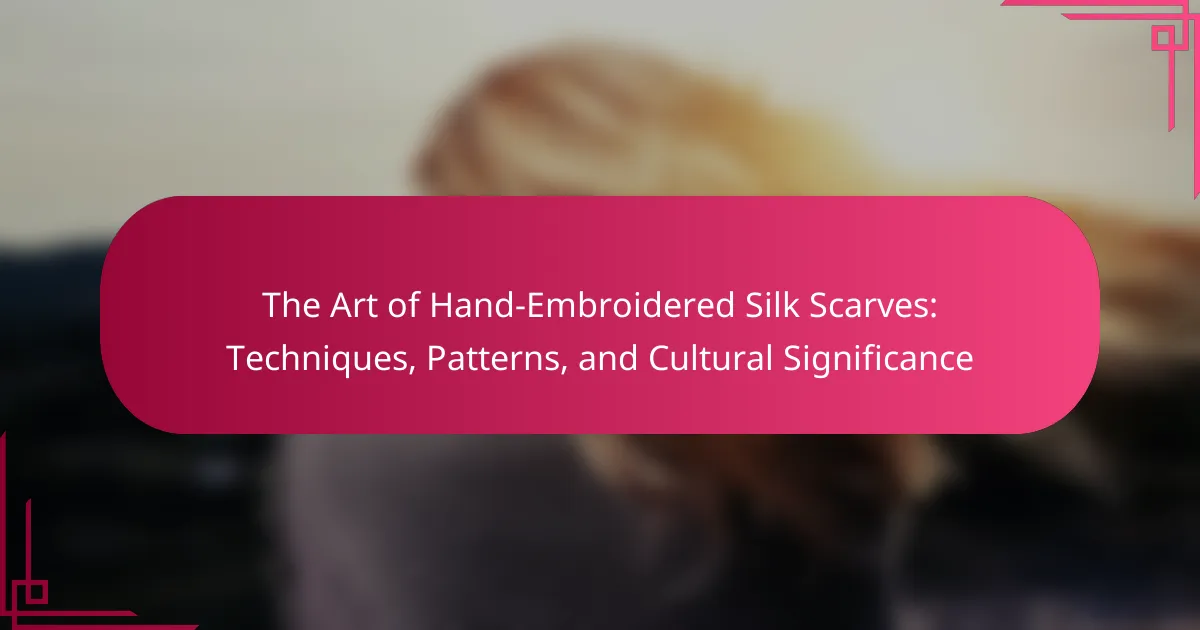Hand-embroidered silk scarves are luxurious textiles characterized by intricate designs achieved through manual stitching techniques. This article explores the craftsmanship involved in creating these scarves, highlighting various embroidery methods such as satin stitch, backstitch, and chain stitch, each contributing unique textures and visual effects. It also examines common patterns like floral designs, geometric shapes, and paisley motifs, which reflect cultural heritage and artistry. Additionally, the article discusses the growing consumer interest in artisanal products and the potential for the luxury scarf market to expand, driven by sustainability trends and enhanced visibility through e-commerce and social media.
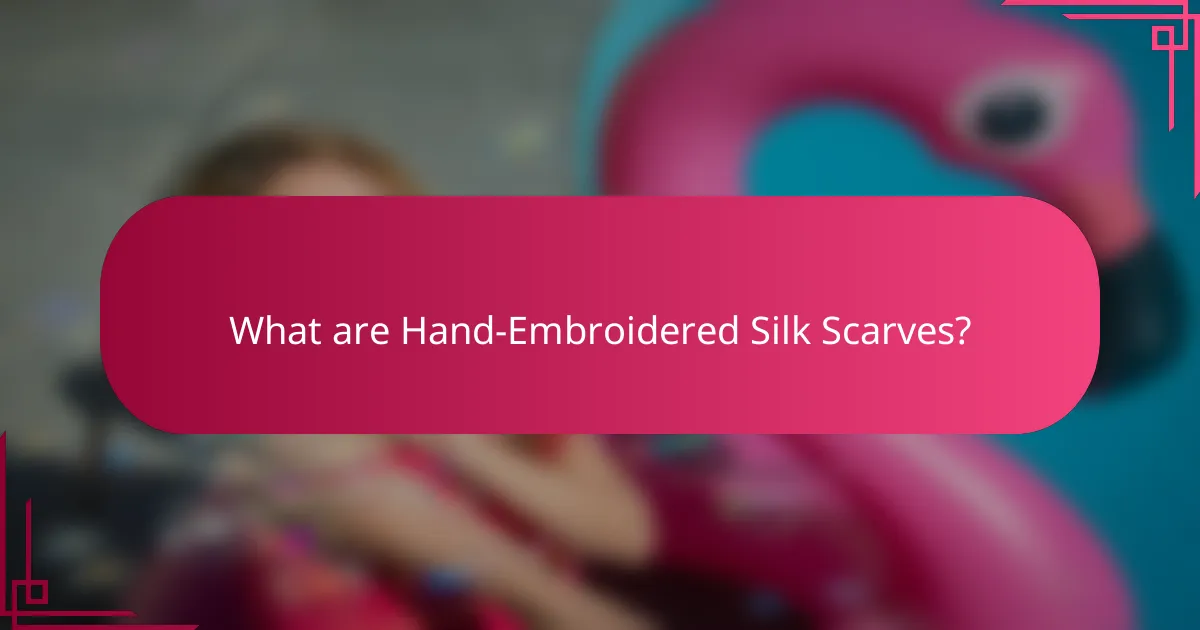
What are Hand-Embroidered Silk Scarves?
Hand-embroidered silk scarves are luxurious textiles featuring intricate designs created through manual stitching. These scarves are made from high-quality silk, known for its softness and sheen. The embroidery adds unique patterns and textures, enhancing the aesthetic appeal. Hand embroidery techniques vary by culture, often reflecting traditional art forms. Each scarf can take hours or days to complete, showcasing the skill of the artisan. The craftsmanship involved in creating these scarves often elevates them to collectible art pieces. Their cultural significance can be traced back to various regions, where they symbolize heritage and artistry.
How are Hand-Embroidered Silk Scarves made?
Hand-embroidered silk scarves are made through a meticulous process involving several steps. First, high-quality silk fabric is selected for its smooth texture and sheen. Next, artisans sketch the desired design onto the silk, ensuring precision. After that, they prepare embroidery threads, often using silk or cotton for vibrant colors.
The artisans then use various stitching techniques, such as satin stitch or chain stitch, to bring the design to life. This process requires skill and patience, as each stitch is placed carefully. Once the embroidery is complete, the scarf is washed to remove any markings and to enhance the silk’s luster.
Finally, the edges of the scarf are often finished with a hem or decorative stitching to prevent fraying. This traditional craft has been practiced for centuries, showcasing the cultural significance and artistic heritage of the region.
What materials are essential for creating Hand-Embroidered Silk Scarves?
Silk fabric is essential for creating hand-embroidered silk scarves. This material provides a smooth surface for embroidery and a luxurious finish. Embroidery thread, often made from silk or cotton, is crucial for adding intricate designs. Needles specifically designed for embroidery facilitate detailed stitching. An embroidery hoop helps keep the fabric taut during the stitching process. Scissors are necessary for trimming threads and finishing touches. Finally, a fabric stabilizer may be used to prevent the silk from shifting while embroidering. Together, these materials enable the creation of beautiful and intricate hand-embroidered silk scarves.
What techniques are commonly used in the embroidery process?
Common techniques used in the embroidery process include satin stitch, backstitch, and cross-stitch. Satin stitch creates a smooth, shiny surface by filling in areas with closely spaced stitches. Backstitch provides a strong outline and is often used for detailing. Cross-stitch forms an X shape and is popular for creating patterns. Other techniques include chain stitch, which creates a decorative chain-like effect, and French knots, which add texture. These techniques are foundational in various embroidery styles and are essential for creating intricate designs on silk scarves.
What cultural significance do Hand-Embroidered Silk Scarves hold?
Hand-embroidered silk scarves hold significant cultural importance in various societies. They often represent traditional craftsmanship and artistic heritage. These scarves are frequently used in ceremonial occasions, symbolizing status and identity. In many cultures, the intricate designs reflect local history and myths. They serve as a means of storytelling through visual art. Additionally, hand-embroidered silk scarves are seen as valuable heirlooms passed down through generations. The use of specific colors and patterns can denote regional affiliation or social standing. Overall, these scarves embody cultural pride and continuity.
How do different cultures approach the art of hand embroidery?
Different cultures approach the art of hand embroidery through unique techniques and styles. In India, intricate patterns and vibrant colors are often used, reflecting local traditions. Chinese embroidery emphasizes precision and symbolism, often depicting nature and mythological themes. Middle Eastern cultures showcase geometric designs and calligraphy, emphasizing cultural identity. In South America, bold colors and patterns represent indigenous heritage and storytelling. Each culture’s approach is influenced by historical context and available materials. For example, the use of silk in China highlights luxury and craftsmanship. These diverse methods illustrate the cultural significance of hand embroidery globally.
What stories or traditions are conveyed through these scarves?
Hand-embroidered silk scarves convey rich cultural stories and traditions. Each design often reflects the history and heritage of a specific region. For example, motifs may symbolize local folklore, spiritual beliefs, or significant historical events. The colors used in the embroidery can represent various meanings, such as prosperity or love. Additionally, the techniques employed in creating these scarves often pass down artisanal skills through generations. Certain patterns may also denote social status or marital status within a community. Thus, these scarves serve as both artistic expressions and cultural artifacts, preserving and sharing the narratives of their origins.
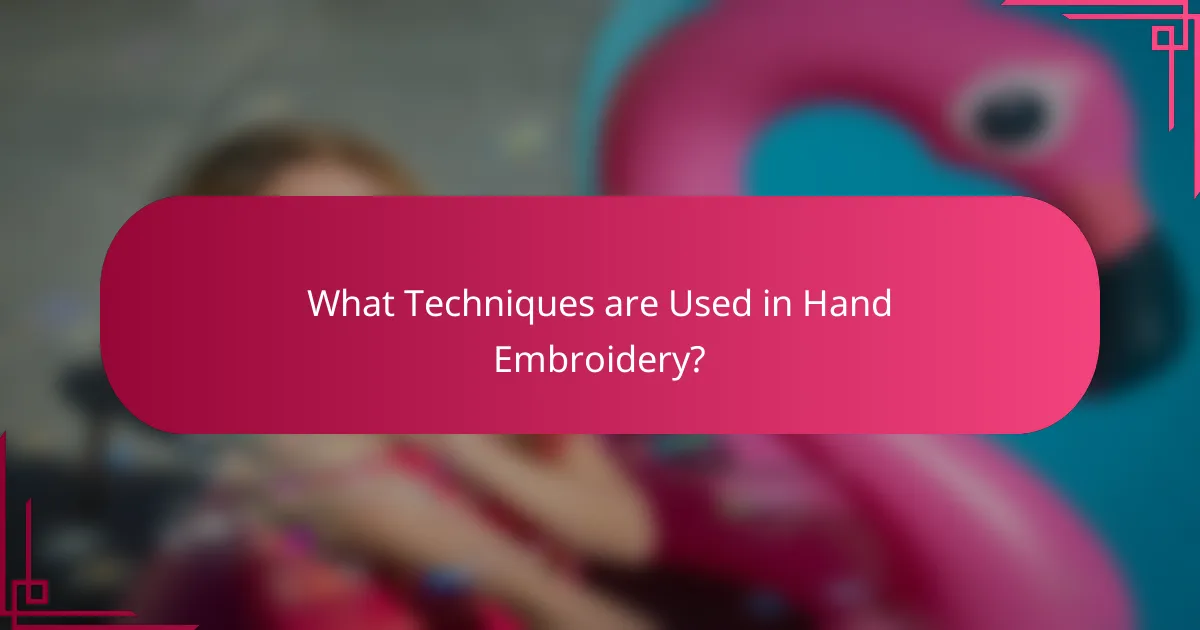
What Techniques are Used in Hand Embroidery?
Hand embroidery employs various techniques to create intricate designs. Common techniques include satin stitch, which fills shapes with smooth, flat stitches. Another technique is backstitch, used for outlining and detailing. Chain stitch forms a series of connected loops, adding texture. French knots create small raised dots for embellishment. Cross-stitch uses X-shaped stitches to form patterns. These techniques have historical significance in various cultures, often passed down through generations. Each technique contributes unique visual effects and textures to embroidered pieces.
What are the most popular embroidery techniques for silk scarves?
The most popular embroidery techniques for silk scarves include silk ribbon embroidery, satin stitch, and chain stitch. Silk ribbon embroidery uses soft ribbons to create textured floral designs. This technique is favored for its three-dimensional quality. Satin stitch is a smooth, flat stitch that provides a rich finish. It is commonly used for filling in shapes and letters. Chain stitch creates a continuous line of stitches resembling a chain. This technique is often used for outlining and adding detail to designs. Each technique enhances the elegance of silk scarves while showcasing the artistry involved in embroidery.
How does each technique affect the final design and texture?
Each embroidery technique significantly influences the final design and texture of silk scarves. Techniques like satin stitch create a smooth, glossy finish that enhances color vibrancy. Conversely, chain stitch adds a textured, raised effect, contributing depth to the design.
Techniques such as cross-stitch introduce a grid-like pattern, offering a more structured appearance. In contrast, freehand embroidery allows for fluid, organic shapes, resulting in a softer texture.
The choice of thread thickness also impacts texture; thicker threads create a bolder look, while finer threads yield delicate details. Additionally, techniques involving layering can produce a three-dimensional effect, enriching the overall design.
Each technique’s unique application can transform the scarf’s aesthetic, showcasing the artisan’s skill and creativity.
What tools are required for each embroidery technique?
Embroidery techniques require specific tools for successful execution. For hand embroidery, essential tools include needles, embroidery floss, and fabric. Each needle type varies based on thread thickness and fabric type. Embroidery floss comes in various colors and is often made of cotton or silk. For machine embroidery, a sewing machine, stabilizer, and thread are necessary. The sewing machine must be compatible with embroidery functions. Stabilizers support the fabric during stitching to prevent distortion. For cross-stitch, aida fabric, cross-stitch needles, and a hoop are essential. Aida fabric has a grid pattern that simplifies counting stitches. Overall, each technique utilizes distinct tools tailored to its requirements.
How can beginners learn these embroidery techniques?
Beginners can learn embroidery techniques through various methods. They can start by taking online courses or watching tutorial videos. Many websites and platforms offer structured lessons for beginners. Books on embroidery techniques are also helpful resources. Local craft stores often provide workshops for hands-on learning. Joining embroidery groups or forums can offer support and advice. Practicing regularly is essential for skill improvement. Accessing free patterns online can help beginners apply what they learn.
What resources are available for learning hand embroidery?
Online courses are available for learning hand embroidery. Websites like Craftsy and Skillshare offer structured classes. YouTube hosts numerous tutorials covering various techniques. Books on embroidery provide detailed instructions and patterns. Local craft stores often conduct workshops. Social media groups foster community learning and sharing. Embroidery blogs offer tips and project ideas. These resources cater to all skill levels, from beginners to advanced artisans.
What are some common mistakes to avoid when starting out?
Common mistakes to avoid when starting out in hand-embroidered silk scarves include inadequate planning. New embroiderers often skip designing their patterns, leading to unsatisfactory results. Another mistake is using the wrong type of thread. Silk thread is essential for achieving the desired sheen and texture. Additionally, neglecting to practice basic stitches can result in uneven work. Beginners may also overlook the importance of fabric preparation, which affects the embroidery’s final appearance. Lastly, not investing in quality tools can hinder the overall craftsmanship. Quality needles and hoops are crucial for precision and ease of work.
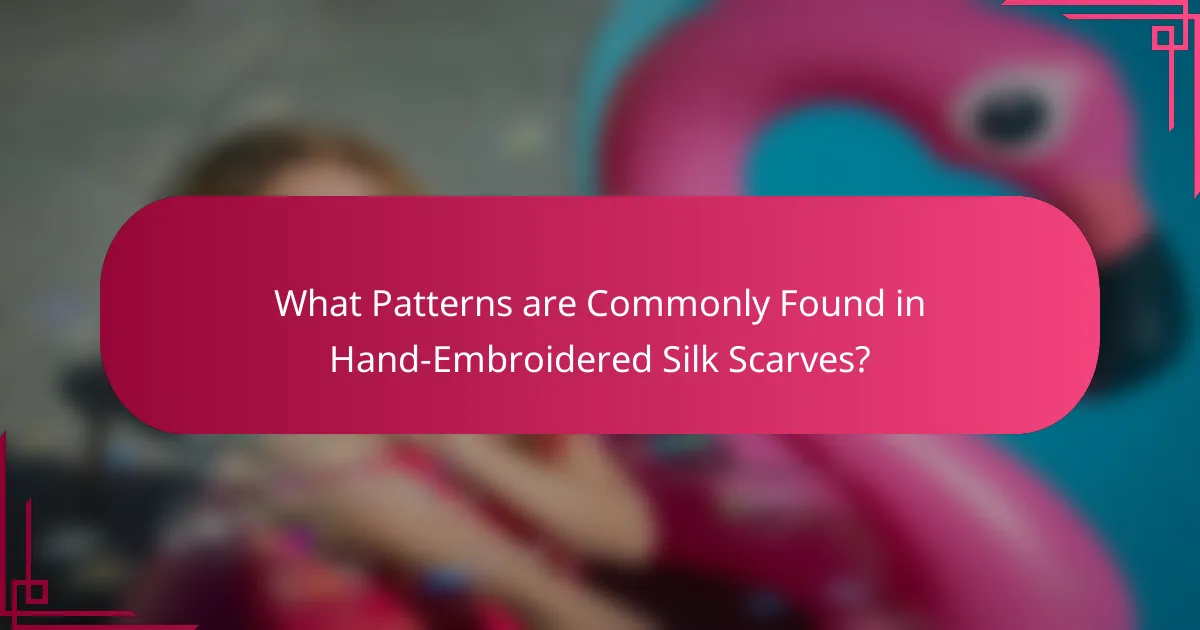
What Patterns are Commonly Found in Hand-Embroidered Silk Scarves?
Common patterns found in hand-embroidered silk scarves include floral designs, geometric shapes, and paisley motifs. Floral designs often feature intricate blossoms and leaves, reflecting nature’s beauty. Geometric shapes provide a modern aesthetic, with lines and angles creating visual interest. Paisley motifs are characterized by their teardrop shape, originating from Persian culture. Other patterns may include ethnic designs, which showcase cultural heritage and storytelling. Each pattern type can vary in color and complexity, adding to the uniqueness of each scarf. These patterns are often chosen for their aesthetic appeal and cultural significance.
What types of patterns are popular in hand-embroidered silk scarves?
Floral patterns are popular in hand-embroidered silk scarves. These designs often feature intricate depictions of flowers and leaves. Geometric patterns are also common, showcasing symmetrical shapes and lines. Traditional motifs, such as paisleys and mandalas, are frequently used. Cultural symbols and icons can be found in many scarves, reflecting regional artistry. Nature-inspired themes, including birds and landscapes, add diversity to the designs. The popularity of these patterns is supported by their historical significance and aesthetic appeal. Each pattern type enhances the uniqueness of hand-embroidered silk scarves.
How do patterns reflect cultural or regional influences?
Patterns reflect cultural or regional influences through their design elements and symbolism. Specific motifs often represent historical, religious, or social themes unique to a culture. For instance, floral patterns may signify fertility in some cultures, while geometric shapes can reflect Islamic art traditions. The color palette used in patterns also conveys cultural meanings; red might symbolize luck in Chinese culture, while blue can represent tranquility in many Western contexts. Regional techniques, such as weaving or dyeing methods, further enhance the uniqueness of patterns, showcasing local craftsmanship. Historical trade routes have influenced patterns, leading to a blend of styles across regions. These patterns serve as visual narratives, telling stories of identity, heritage, and community values.
What are the most sought-after designs in the market today?
Floral patterns are the most sought-after designs in the hand-embroidered silk scarf market today. These designs often feature intricate blossoms and leaves, appealing to consumers’ love for nature. Geometric patterns also hold popularity, providing a modern aesthetic that attracts fashion-forward individuals. Cultural motifs, reflecting heritage and traditional artistry, are increasingly desired for their uniqueness. According to a recent market analysis, floral designs account for over 40% of sales in this category. Geometric designs follow closely, making up about 25% of the market. Cultural motifs are gaining traction, with a growth rate of 15% year-over-year. This trend indicates a growing appreciation for artistry and craftsmanship in fashion accessories.
How can one choose the right pattern for a silk scarf?
To choose the right pattern for a silk scarf, consider personal style and occasion. Analyze the colors that complement your wardrobe. Look for patterns that reflect your personality, such as florals or geometric designs. Evaluate the size of the scarf; larger patterns may work better on bigger scarves. Consider the cultural significance of patterns, as some may hold specific meanings. Research the history of silk scarf designs to appreciate their context. Lastly, choose a pattern that resonates with you emotionally, enhancing your overall outfit.
What factors should be considered when selecting a pattern?
When selecting a pattern for hand-embroidered silk scarves, consider the design’s cultural significance. Patterns can reflect specific traditions and meanings within various cultures. Color harmony is also crucial; choose colors that complement each other and the silk’s sheen. The complexity of the pattern matters; simpler designs may be more suitable for casual wear, while intricate patterns can elevate formal attire. Additionally, consider the intended audience; patterns should resonate with the target demographic. Fabric compatibility is important; ensure the pattern aligns with the silk’s texture and drape. Lastly, durability of the design is essential; some patterns may wear better over time than others.
How do personal style and occasion influence pattern choice?
Personal style and occasion significantly influence pattern choice in hand-embroidered silk scarves. Personal style reflects individual preferences and aesthetics. For instance, someone with a minimalist style may prefer simple, geometric patterns. In contrast, a person who enjoys vibrant colors may choose floral or abstract designs.
Occasion also plays a crucial role. Formal events often call for elegant, understated patterns. Casual gatherings might allow for playful, bold designs. Seasonal occasions, like holidays, can inspire specific motifs. For example, winter scarves may feature snowflakes or holiday themes.
Research indicates that consumers often select patterns that resonate with their identity and the context of their wear. This interplay between personal taste and situational appropriateness shapes the overall appeal of the scarf.
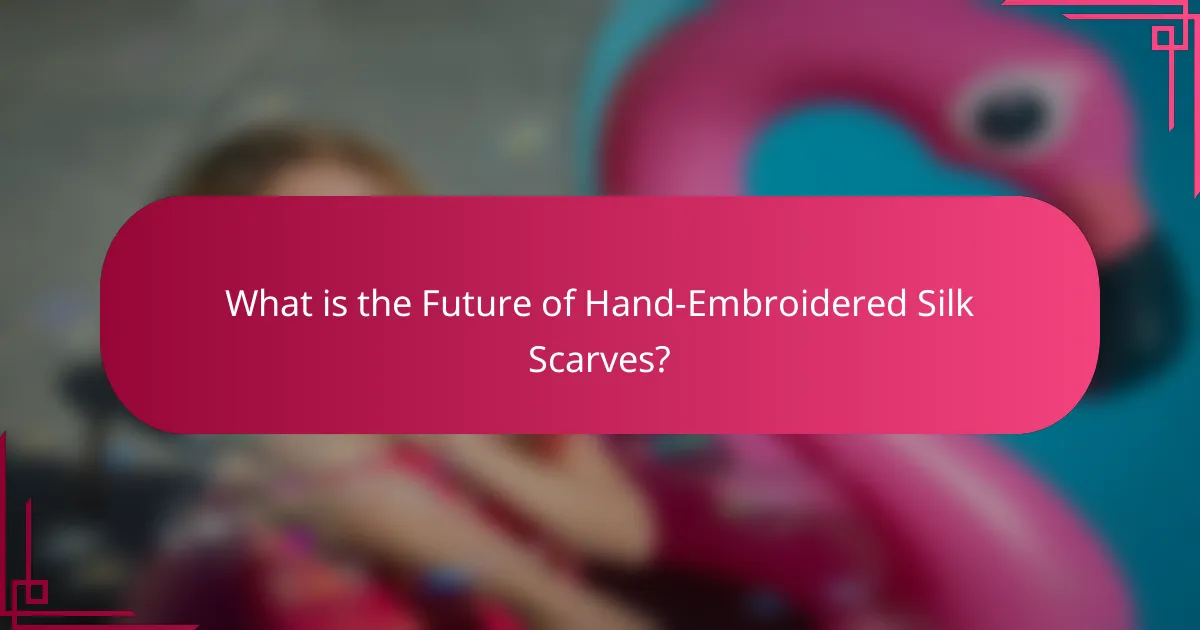
What is the Future of Hand-Embroidered Silk Scarves?
The future of hand-embroidered silk scarves appears promising due to increasing consumer interest in artisanal products. As sustainability becomes a priority, handcrafted items are gaining popularity. Consumers are seeking unique, high-quality accessories that reflect individuality. The global market for luxury scarves is projected to grow, indicating strong demand. Furthermore, advancements in e-commerce enable artisans to reach wider audiences. Social media platforms are facilitating the promotion of these products. Collaborations between artisans and fashion brands are likely to enhance visibility. Overall, the combination of cultural appreciation and market trends suggests a bright future for hand-embroidered silk scarves.
How is technology influencing the art of hand embroidery?
Technology is significantly influencing the art of hand embroidery by introducing new tools and techniques. Digital embroidery machines allow for intricate designs that were previously time-consuming. Software programs enable artists to create and modify patterns easily. Online platforms facilitate sharing techniques and tutorials among embroiderers globally. Social media promotes visibility for artists and their work, expanding their audience. Additionally, technology provides access to a wide range of materials and threads, enhancing creativity. These advancements contribute to a modern evolution of traditional hand embroidery practices.
What innovations are emerging in materials and techniques?
Innovations in materials and techniques for hand-embroidered silk scarves include the use of eco-friendly dyes and advanced embroidery machines. Eco-friendly dyes reduce environmental impact while maintaining vibrant colors. Advanced embroidery machines enhance precision and efficiency in stitching patterns. Additionally, digital printing technology allows for intricate designs to be replicated easily on silk. Innovations in silk production, such as the development of sustainable silk farming practices, contribute to ethical sourcing. These advancements reflect a growing trend towards sustainability in textile arts.
How can artisans adapt to changing consumer preferences?
Artisans can adapt to changing consumer preferences by incorporating modern design trends into their work. They should conduct market research to understand current demands. Engaging with consumers through social media can provide valuable insights. Artisans can also experiment with sustainable materials, as eco-consciousness is rising. Customization options can attract consumers seeking unique products. Collaborating with influencers can enhance visibility and reach. Additionally, attending craft fairs helps artisans gauge consumer reactions firsthand. By being flexible and innovative, artisans can remain relevant in a dynamic market.
What tips can enhance the appreciation and care of hand-embroidered silk scarves?
To enhance the appreciation and care of hand-embroidered silk scarves, store them properly. Use a cool, dry place away from direct sunlight. Avoid folding to prevent creases; roll them instead. Clean them gently with a soft, damp cloth to remove dust. For deeper cleaning, consider professional dry cleaning. Handle them with clean hands to avoid oils and dirt transfer. Display them in a way that showcases their artistry, such as framing or hanging. Educate yourself about the embroidery techniques used to deepen your appreciation. These practices help maintain the scarf’s quality and aesthetic appeal.
How should one properly care for a hand-embroidered silk scarf?
To properly care for a hand-embroidered silk scarf, gently hand wash it in cold water. Use a mild detergent specifically designed for silk. Avoid wringing or twisting the scarf to prevent damage. Rinse thoroughly to remove all detergent. Lay the scarf flat on a clean towel to dry, reshaping it as needed. Keep the scarf away from direct sunlight to prevent fading. Store it folded in a cool, dry place to maintain its quality. Following these steps preserves the intricate embroidery and silk fabric.
What are the best practices for displaying and storing these scarves?
The best practices for displaying and storing hand-embroidered silk scarves include using padded hangers and breathable fabric bags. Padded hangers prevent creases and maintain the scarf’s shape. Breathable fabric bags protect scarves from dust while allowing air circulation. Avoid plastic storage, as it can trap moisture and cause mildew. Store scarves in a cool, dry place away from direct sunlight to prevent fading. Regularly check for signs of wear or damage to ensure longevity. These methods preserve the quality and beauty of silk scarves over time.
Hand-embroidered silk scarves are luxurious textiles characterized by intricate designs created through manual stitching techniques. This article explores the making of these scarves, detailing essential materials, popular embroidery techniques, and their cultural significance across various regions. It also examines common patterns, consumer preferences, and the impact of technology on traditional craftsmanship. Additionally, best practices for care, storage, and display of these unique accessories are outlined, highlighting their value as both art pieces and cultural artifacts.
